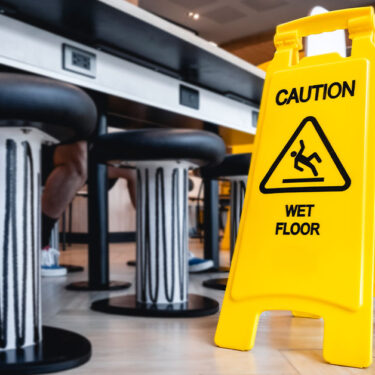Xylem Inc. was recently fined $234,054 by the U.S. Department of Labor’s Occupational Safety and Health Administration (OSHA) after a 2020 incident in which a worker was hurt while lowering himself into a water test pit. The injury reportedly took place at the water technology company’s location in Pewaukee, Wisconsin when a guardrail loosened as the worker entered the almost 30-feet-deep pit, causing him to fall and hit his head on a support beam.
Inspections by OSHA, which was notified of the injury on Oct. 29, 2020, later identified multiple hazards at the site and the regulator subsequently issued penalties for one willful and eight serious safety violations. The employee’s injury “could have been prevented” had appropriate fall protection been provided, OSHA area director Christine Zortman said in a news release announcing the citations.
“OSHA has regulations for protecting workers who enter confined spaces, including having rescue equipment available and attendants ready to ensure their co-workers’ safety and to call for rescue services if necessary,” Zortman continued in the release.
The situation demonstrates the necessity of companies staying up to date on OSHA requirements and having the appropriate safety measures in place, said Justin Dorman, National Product Manager, Workers’ Compensation, Burns & Wilcox, Charleston, South Carolina. They also need to carry Workers’ Compensation Insurance, which can provide medical and indemnity coverage for employee injuries.
“Any business should be aware of their operations and what guidelines they are required to follow,” Dorman said.
Workplace injuries not uncommon; certain industries more affected
In 2019, private industry employers in the U.S. reported 2.8 million nonfatal workplace injuries and illnesses, including 888,220 cases that caused a worker to miss at least one day of work, according to the Bureau of Labor Statistics.1 These figures are similar to those from 2018, the agency noted. The occupations that had the most injuries in 2019 included laborers and freight, stock, and material movers, along with heavy and tractor-trailer truck drivers.
Still, any workplace could be the site of an injury. “Accidents do happen, of course,” Dorman said. “That is why Workers’ Compensation Insurance is vital for any company, and that is why it is required by law in most states and for most companies.”
Workers’ Compensation Insurance is regulated by individual states but covered expenses typically include medical treatment, partial salary reimbursement if the employee is unable to work, rehabilitation, and vocational training when needed.
“This allows the employee who is hurt to get back to work, get rehabilitation, and whatever else they may need,” Dorman said, noting that survivor benefits can also be provided for the dependents of those who are fatally injured at work. “That can all be taken care of through the Workers’ Compensation Insurance policy the company has in place.”
States set limits for short- and long-term medical costs, resulting in varying rates depending on the state, Dorman explained. “There is no limit except for what the state sets based on the type of injury and whether it is a permanent or total disability,” he said.
The potential frequency and severity of claims, including a company’s history of workplace injuries, may also play a role in rates. Restaurants, for example, may see more minor injury claims such as cuts or slip-and-falls. In 2019, private industry workers in full-service restaurants suffered 93,800 nonfatal injuries, one-third of which sent workers home for at least one day.2
“When the insurance carriers are rating these policies, they take all of that into account,” Dorman said. “If you have a few losses and that is normal for your industry, the carrier will know that.”
Also in 2019, 5,333 fatal workplace injuries occurred in the U.S., amounting to one worker dying every 99 minutes from a work-related injury.3 The leading type of fatal workplace accident was transportation incidents, followed by falls, violence and other injuries by an individual or animal, contact with objects or equipment, exposure to harmful substances, and fires and explosions.
Workers’ Compensation Insurance protects employees, employers
On April 29, a city utility employee in Albion, Nebraska had to be rescued from a trench where workers were repairing a water line leak.4 When a portion of the trench wall sloughed off, the worker was pushed against a large pipe and suffered hip and leg injuries. It is just one of many employee injuries that occur daily in the U.S., where some believe workplace injuries may be underestimated.5
In some cases, a company can be sued by an injured employee if the employer knowingly endangered the worker. Last year, a kite performer who suffered a traumatic brain injury at work filed a lawsuit with her mother against her employer, alleging that the company did not ensure her safety before starting a show. The woman was awarded $200,000 in a settlement for her injury, which was allegedly not reported to OSHA.6

Workers’ Compensation Insurance protects the business from financially going under due to employee lawsuits, and it protects the employees in knowing they are going to get the treatment they need.
Employers’ Liability Insurance, a separate portion of Workers’ Compensation Insurance that protects the business from claims not covered by Workers’ Compensation, could cover this type of situation. If an employer is sued over a workplace injury that could have been prevented, Employers’ Liability Insurance can help cover the cost of legal defense and settlement, Dorman said. Fines assessed by OSHA are not covered by Workers’ Compensation Insurance.
“If the company willingly knew about violations and did nothing to fix them, most likely that could show up on the Employers’ Liability Insurance section, because it is their liability to take care of that,” Dorman explained. “In that case, it is not so much a medical claim about getting the employer back to work, but instead is for punitive-type damages where they are suing because they should not have been hurt.”
Though Employers’ Liability Insurance lawsuits are rare, “it is still nice to have that stopgap coverage,” he said.
Ultimately, Workers’ Compensation Insurance helps to protect both the employer and the employee. “It protects the business from financially going under due to employee lawsuits, and it protects the employees in knowing they are going to get the treatment they need,” Dorman said. “For the employer, you know you are not going to lose your business if one of your workers gets injured or dies. It is a financial backstop, which offers that peace of mind. For the employees, if you get injured, you know it is not going to come out of your pocket. You will be taken care of.”
This makes Workers’ Compensation Insurance among the most important insurance policies for companies. “If we do not have financially secure employers, we are not going to have a very strong economy,” he said.
Risk management, OSHA compliance critical
In fiscal year 2020, OSHA conducted 21,674 workplace inspections, including 1,508 inspections related to workplace fatalities and 4,581 in response to complaints.7 Coronavirus-related violations alone resulted in proposed penalties of over $3.9 million last year.8 These penalties are avoidable, Dorman emphasized, and it is an employer’s responsibility to keep up with OSHA guidelines.
“OSHA violations should be easy to avoid,” he said. “A full-time loss control manager on site doing routine inspections and ensuring compliance with OSHA regulations can be very helpful. OSHA regulations change frequently. Making sure that you are always in compliance is extremely important.”
Beyond the risk of injury or penalty, “safety impacts everybody,” Dorman added. “There is also the bad publicity and bad faith they may get from injuries that appear in the news,” he said. “For the consumer, as well, it is important that companies have strong workplace safety. It affects the whole supply chain.”
With up to 1 in 4 Americans expected to still be working remotely in 2021, employers must also consider the safety of at-home office environments.9 There may even be some “gray area” when it comes to workers who are injured while at home but not necessarily while completing work. In 2019, a state appeals court ruled that a Florida woman who tripped over her dog while working from home is not entitled to Workers’ Compensation benefits for her injuries.10

OSHA regulations change frequently. Making sure that you are always in compliance is extremely important.
“Where do you draw that line in the home between where business happens and where personal life happens? It has been a little bit difficult,” Dorman said. “However, it does not appear that many individuals are abusing the system, which is good to see.”
Employers should know that every workplace injury must be reported as soon as possible. Although some employers may believe reporting the claim will adversely affect their Workers’ Compensation Insurance policy, “you want the worker to get the help they need as soon as possible to avoid a larger claims scenario in the future.”
Workers’ Compensation Insurance has been offered at historically low rates for the past five to six years, Dorman pointed out. This is due in part to improved workplace safety and flattening medical costs. “Now, with COVID-19 and the way it has impacted the economy, you may start seeing less of a cushion for Workers’ Compensation Insurance, and we are already seeing that this year,” he said. “The market will probably start to level out, although I do not believe we will see a hard market.”
Companies struggling to afford their Workers’ Compensation Insurance rates should keep in mind that most carriers offer payment plans on their accounts, unlike with other types of insurance. “Workers’ Compensation Insurance carriers know that their customers need a flexible payment plan,” he said.
It is best for employers to be open with their insurance broker about any hazards at their facilities and how they address those risks. “That allows us to approach our markets as quickly as possible and provide the best turnaround and service,” Dorman said. “We want to get the best quote for our agents and our clients.”
Sources
1U.S. Bureau of Labor Statistics. “Employer-Reported Workplace Injuries and Illnesses (Annual) News Release.” United States Government, November 4, 2020. 2U.S. Bureau of Labor Statistics. “93,800 nonfatal injuries and illnesses in full-service restaurants in 2019.” United States Government, December 4, 2020. 3U.S. Bureau of Labor Statistics. “One worker died every 99 minutes from a work-related injury in 2019.” United States Government, December 18, 2020. 4Albion News. “Albion city worker injured in trench accident.” Albion News and Boone County Tribune, April 30, 2021. 5Michaels, David. “America’s Workplaces Are Still Too Dangerous.” The New York Times, April 28, 2021. 6Russon, Gabrielle. “She was supposed to perform in an Epcot show at Disney. Instead, a brain injury upended her life.” Orlando Sentinel, May 3, 2021. 7U.S. Department of Labor. “Occupational Safety and Health Administration (OSHA) Enforcement.” United States Government, November 9, 2020. 8U.S. Department of Labor. “U.S. Department of Labor’s OSHA Announces $3,930,381 In Coronavirus Violations.” United States Government, January 8, 2021. 9Ioannou, Lori. “1 in 4 Americans will be working remotely in 2021, Upwork survey reveals.” CNBC, December 15, 2020. 10Saunders, Jim. “Court rejects workers’ comp for at-home fall.” The News Service of Florida, April 8, 2019.




